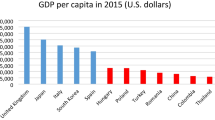Abstract
Fixed operating costs draw a sharp distinction between endogenous growth based on horizontal and vertical innovation: a larger number of product lines puts pressure on an economy’s resources; greater productivity of existing product lines does not. Consequently, the only plausible engine of endogenous growth is vertical innovation whereby progress along the quality or cost ladder does not require the replication of fixed costs. Is, then, product variety expansion irrelevant? No. The two dimensions of technology are complementary in that using one and the other produces a more comprehensive theory of economic growth. The vertical dimension allows endogenous growth unconstrained by endowments, the horizontal provides the mechanism that translates changes in aggregate variables into changes in product-level variables, which ultimately drive incentives to push the technological frontier in the vertical dimension. We show that the potential for exponential growth due to an externality that makes entry costs fall linearly with the number of products, combined with the limited carrying capacity of the system due to fixed operating costs, yields logistic dynamics for the number of products. This desirable property allows us to provide a closed-form solution for the model’s transition path and thereby derive analytically the welfare effects of changes in parameters and policy variables. Our Manhattan Metaphor illustrates conceptually why we obtain this mathematical representation when we simply add fixed operating costs to the standard modeling of variety expansion.
Similar content being viewed by others
References
Aghion P., Howitt P. (1998) Endogenous growth theory. MIT University Press, Cambridge
Banks R. (1994) Growth and diffusion phenomena. Springer-Verlag, New York
Barro R., Sala-i-Martin X. (2004) Economic growth. MIT University Press, Cambridge
Connolly M., Peretto P.F. (2003) Industry and the family: Two engines of growth. Journal of Economic Growth 8: 115–148
Cozzi, G., & Spinesi, L. (2002). Quasi-fixed costs and the returns to innovation. Manuscript, University of Rome “La Sapienza”.
Etro F. (2004) Innovation by leaders. Economic Journal 114, 281–303
Grossman G.M., Helpman E. (1991) Innovation and growth in the global economy. MIT University Press, Cambridge
Ha J., Howitt P. (2007) Accounting for trends in productivity and R&D: A Schumpeterian critique of semi-endogenous growth theory. Journal of Money Credit and Banking 38(4): 733–774
Howitt P. (1999) Steady endogenous growth with population and R&D inputs growing. Journal of Political Economy 107: 715–730
Laincz C., Peretto P.F. (2006) Scale effects in endogenous growth theory: An error of aggregation, not specification. Journal of Economic Growth 11: 263–288
Minniti, A. (2006). Multi-product firms, R&D, and growth. The B.E. Journal of Macroeconomics, 6(3), (Topics).
Peretto P.F. (1996) Sunk costs, market structure and growth. International Economic Review 37: 895–923
Peretto P.F. (1998) Technological change and population growth. Journal of Economic Growth 3: 283–311
Peretto, P. F. (2007a). Corporate taxes, growth and welfare in a Schumpeterian economy. Journal of Economic Theory, forthcoming.
Peretto, P. F. (2007b). Schumpeterian growth with productive public spending and distortionary taxation. Review of Development Economics, forthcoming.
Peretto, P. F. (2007c). Energy taxes and endogenous technological change. Manuscript, Department of Economics, Duke University.
Peretto P.F., Smulders S. (2002) Technological distance, growth, and scale effects. The Economic Journal 112: 603–624
Romer P. (1987) Growth based on increasing returns due to specialization. American Economic Review Papers and Proceedings 77: 56–72
Romer P. (1990) Endogenous technological change. Journal of Political Economy 98: S71–S102
Smulders S., van de Klundert T. (1995) Imperfect competition, concentration and growth with firm-specific R&D. European Economic Review 39: 139–160
Author information
Authors and Affiliations
Corresponding author
Rights and permissions
About this article
Cite this article
Peretto, P.F., Connolly, M. The Manhattan Metaphor. J Econ Growth 12, 329–350 (2007). https://doi.org/10.1007/s10887-007-9023-1
Published:
Issue Date:
DOI: https://doi.org/10.1007/s10887-007-9023-1




